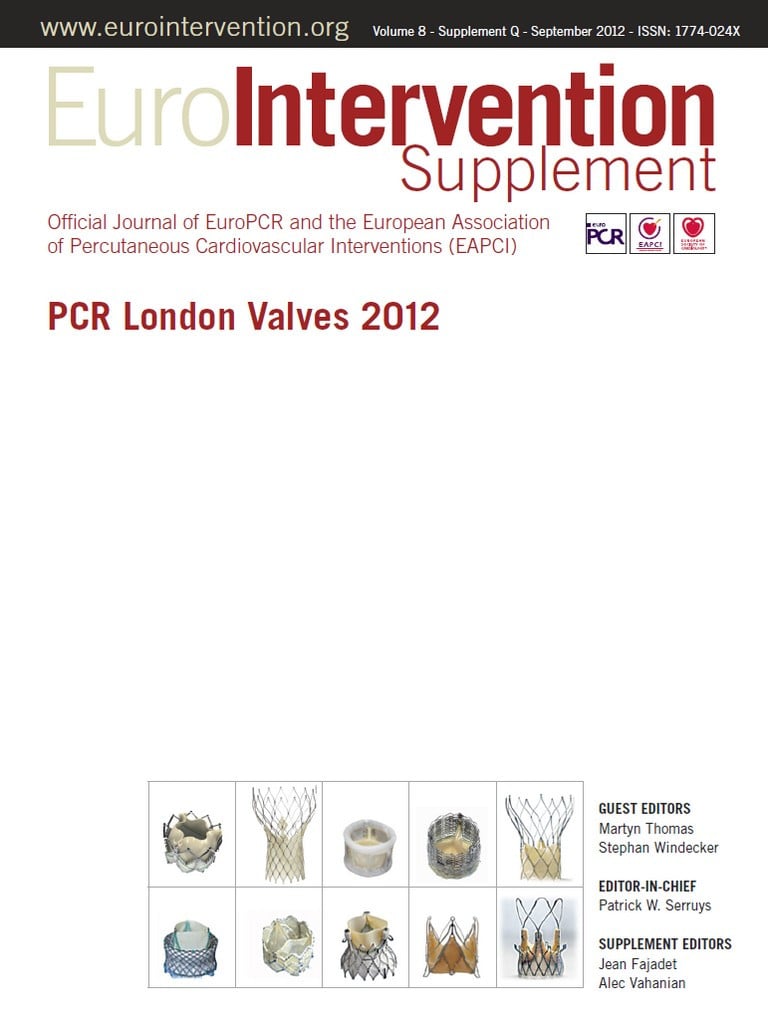![]()
Treatment and consequences of regurgitation during transcatheter valve therapies
Percutaneous closure of paravalvular aortic leaks with the Amplatzer Vascular Plug III ®, late clinical follow-up
Aims: Percutaneous closure of aortic paravalvular leaks (APL) has been presented as an alternative to reoperation. Our objective was to describe our population undergoing percutaneous repair of APL with the Amplatzer Vascular Plug III® (AVP III) device and describe clinical events.
Methods and results: All patients were considered who underwent percutaneous repair of at least one APL where the AVP III device was used. Results are reported as medians and differences in chi-square. There were 12 patients aged 67±14 years. The number of aortic valve surgeries was 2.03±0.96. Interval time from the last surgery to percutaneous closure of the APL was 7.61±7.66 years. Nine patients had mechanical valve prosthesis, four patients also had a mechanical mitral valve and presented a mitral paravalvular leak. Clinical presentation: 30% had heart failure, 10% haemolytic anaemia and 60% both. The NYHA functional Class 3±0.58, haematocrit 28.7±4.9%, LDH 1,219±928 UI/L. Echocardiography: LVEF 60±9%; systolic PAP: 55±28 mmHg; numbers of APL 16; degree of regurgitation 3.2±0.8; EuroSCORE 14±4. In 13 procedures, 13 APL were attempted; the wire was crossed retrograde in 12 APL, an arterial venous loop was established in 4 patients where the delivery sheath was advanced anterograde. The procedure was successful in 11 patients and 11 APL with 1.09 AVP III devices implanted. Simultaneous mitral and aortic closure was accomplished in three patients. Functional outcome of the procedure decreased APL regurgitation in 1±0.8 grades. Periprocedural events: pacemaker one patient (the pacemaker electrode moved while making the arteriovenous loop), femoral pseudoaneurysm: one patient, and mortality one patient (he did not have AVP III deployed and died three days later of heart failure). Follow-up 642±397 days. Ninety-one per cent of patients with AVP III show improvement of functional class by at least 1 grade, NYHA functional Class at follow-up was 2±0.9 p=0.004, haematocrit 35±4.3% p=0.03, LDH 438±353 UI p=0.04 and APL regurgitation 1±1.1 p=0.01. Late clinical events: new intervention for moderate to severe residual APL regurgitation in two patients (one patient at surgery at 246 days and one patient with new percutaneous repair with new AVP III at 727 days). Hospitalisation for aortic regurgitation: two patients; late mortality in one patient at 831 days of coronary artery disease.
Conclusions: Percutaneous closure of APL using an AVP III device is safe with high rate of immediate procedural success. Patients presented late clinical improvement in both functional classes and haematocrits, and a significant decrease in aortic periprosthetic regurgitation.

